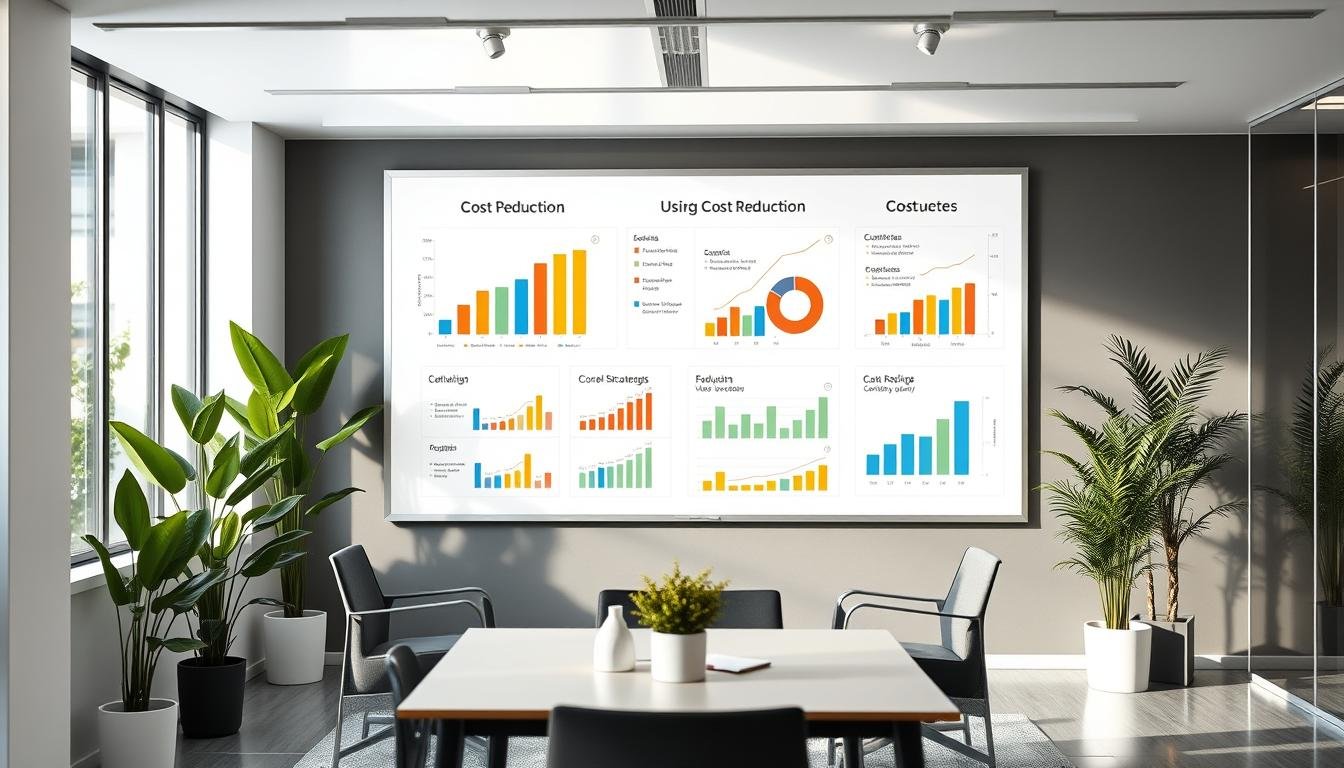Did you know that businesses can save up to 30% on operating costs by implementing effective cost reduction strategies? This staggering statistic underscores the importance of expense management and budget optimization in achieving significant financial efficiency. In today’s competitive market, companies must focus on reducing costs without compromising quality or customer satisfaction. This article explores various methods to help organizations optimize their expenses and achieve substantial savings, ultimately leading to enhanced profitability.
Key Takeaways
- Understanding the impact of cost reduction on overall profitability.
- The importance of thorough expense management for financial success.
- Key strategies include process automation, negotiation, and energy efficiency.
- Establishing a culture of cost savings within the organization.
- Regular review of budgets to ensure ongoing financial efficiency.
- The role of innovative technology in expense management.
Understanding the Importance of Cost Reduction
The significance of cost reduction in the business realm is multifaceted. It not only elevates profitability but also fortifies cash flow and competitive edge. By prioritizing these aspects, enterprises can cultivate financial robustness and ensure enduring viability.
Benefits of Effective Cost Management
Adopting strategies for cost management yields substantial advantages. The primary benefits encompass:
- Increased Profit Margins: Through the optimization of expenses, companies can significantly enhance their profit margins.
- Enhanced Resource Allocation: Effective management enables the more efficient allocation of resources across various departments.
- Improved Financial Resilience: Organizations with robust cost management capabilities are better equipped to navigate economic uncertainties.
Common Misconceptions About Cost Reduction
It is crucial to dispel misconceptions surrounding cost reduction. Many mistakenly equate cost reduction with layoffs, a notion that can stifle strategic cost management efforts. In reality, cost reduction can be achieved through:
- Identifying and rectifying inefficiencies without resorting to workforce reductions.
- Investing in technological advancements to streamline operations.
- Reviewing vendor contracts to secure more favorable terms, rather than solely relying on staff cuts.
Identifying Areas for Cost Reduction
Understanding a company’s financial structure necessitates a deep dive into resource allocation. To pinpoint cost reduction opportunities, businesses first scrutinize their current spending patterns. This initial step uncovers potential savings avenues.
Analyzing Your Current Expenditures
Breaking down expenditures into fixed and variable costs facilitates budgeting. Visualizing spending patterns is crucial. Companies can take several steps to streamline their finances:
- Reviewing historical spending data to identify trends.
- Classifying expenses into essential and non-essential categories.
- Identifying unnecessary expenses that can be reduced or eliminated.
Tools for Expense Analysis
Appropriate expense analysis tools are essential for grasping financial flows. Businesses have access to various tools, including:
- Excel spreadsheets for custom analysis and reporting.
- Expense tracking software that automatically categorizes transactions.
- Cloud-based solutions that offer real-time insights into financial health.
Employing these tools enhances understanding of expenditures, enabling organizations to effectively target cost reduction areas.
Developing a Cost Reduction Plan
The creation of a meticulously crafted cost reduction plan is paramount for any entity seeking to elevate its fiscal standing. This endeavor necessitates a multifaceted strategy, encompassing pivotal components that underpin successful cost-cutting initiatives. By concentrating on high-cost domains and actively engaging stakeholders, corporations can formulate a bespoke cost reduction strategy.
Key Elements of a Cost Reduction Strategy
The success of cost reduction efforts is predicated upon the identification of the core drivers of savings. Consider the following:
- Prioritize high-cost areas: Assess where the most significant expenses occur and target those sectors first.
- Engage stakeholders: Involve team members from all levels to gain insights and foster collaboration.
- Set benchmarks: Establish clear criteria for measuring progress and evaluating success.
These foundational elements of a cost reduction plan enable targeted initiatives, ensuring that efforts yield tangible results.
Setting Realistic Goals
Establishing realistic goals is imperative for guiding the cost reduction process. It is essential to create objectives that are quantifiable and have a specific timeline, fostering accountability among teams. Regularly reassess your goals to accommodate necessary adjustments, ensuring adaptability in a dynamic market. Acquaintance with effective savings strategies, such as those found in financial expert tips, can significantly bolster your approach. By maintaining clarity and focus, businesses can propel efficiency and sustainability in their financial endeavors.
Automating Processes to Reduce Costs
Automation has emerged as a pivotal strategy for businesses aiming to achieve significant cost reduction through automation. By streamlining workflows and minimizing the need for manual intervention, companies can enhance their operational efficiency. The integration of automation technologies offers numerous advantages, leading to more effective resource management.
Benefits of Automation in Business
The automation benefits are manifold, providing businesses with the opportunity to reduce operational costs while improving service delivery. Here are some notable advantages:
- Increased Efficiency: Automating repetitive tasks leads to time savings and allows employees to focus on more strategic initiatives.
- Minimized Errors: Reducing manual input significantly lowers the risk of human error, thereby enhancing the quality of output.
- Faster Service Delivery: Accelerated processes improve responsiveness to customer needs.
- Operational Savings: Streamlined operations contribute to overall cost reduction through automation.
Tools and Software for Automation
To effectively harness the advantages of automation, businesses can utilize various process automation tools. Popular software solutions like Zapier, Trello, and Asana play a vital role in facilitating workflow automation and efficiency. These tools offer features that help in:
- Integrating Platforms: Connecting different applications for seamless data flow.
- Task Management: Automating task assignments based on predefined workflows.
- Monitoring Performance: Tracking process performance to identify areas for further optimization.
Negotiating with Suppliers
The art of supplier negotiation is paramount in the realm of operational cost management, ensuring the procurement of superior materials and services. The cultivation of robust supplier relationships is fundamental to this endeavor. When viewed as collaborative endeavors rather than mere transactions, these partnerships can yield mutually advantageous agreements.
Building Strong Supplier Relationships
The establishment of strong supplier relationships hinges on the pillars of consistent communication and mutual trust. By openly discussing your business objectives with suppliers, you enable them to tailor their offerings to meet your specific requirements. Regularly soliciting feedback from suppliers reinforces a sense of collective purpose and dedication.
Strategies for Successful Negotiation
Effective negotiation strategies are indispensable for securing advantageous terms. Begin by conducting an exhaustive analysis of your suppliers’ businesses and their strategic goals. Prepare compelling, data-driven arguments that underscore the benefits of fulfilling your needs. Remain open to exploring novel options to elevate the negotiation’s value.
- Clearly define your requirements and expectations ahead of time.
- Engage in collaborative discussions about pricing and terms.
- Consider the long-term impact of negotiations on strong supplier relationships.
To enhance your negotiation prowess, refer to resources such as how to negotiate with powerful suppliers. This methodology equips you to adeptly navigate challenges and optimize outcomes. Adhering to these strategies cultivates more effective negotiations, ultimately leading to enduring success.
Implementing Energy Efficiency Measures
Adopting energy efficiency measures unveils a plethora of energy efficiency benefits, profoundly influencing both operational expenses and environmental stewardship. Entities demonstrate their dedication to going green, thereby bolstering their brand image. This commitment to sustainability not only leads to diminished energy expenditures but also fosters regulatory compliance and a robust market standing.
Benefits of Going Green
The transition to energy-efficient methodologies reaps considerable dividends:
- Significant diminution in energy outlays, thereby aiding in cutting energy costs.
- Augmented public perception among the burgeoning eco-aware consumer base.
- Adherence to stringent environmental standards at both local and federal levels.
Tips for Reducing Energy Costs
Effective implementation necessitates the adoption of pragmatic strategies:
- Transition to energy-efficient appliances that exhibit lower power consumption.
- Employ smart technology for the monitoring and management of energy consumption.
- Conduct periodic energy audits to pinpoint avenues for enhancement.
- Investigate financing avenues for the integration of energy-saving upgrades. For additional guidance, refer to financial success tips.
Streamlining Operations
The imperative of streamlining operations for businesses seeking to augment productivity and diminish unnecessary expenditures cannot be overstated. The implementation of lean management principles enables organizations to concentrate on the eradication of waste and the optimization of each process step. This strategic methodology not only reduces expenses but also elevates overall productivity through the enhancement of workflows.
Principles of Lean Management
Lean management principles provide a framework for businesses to elevate operational efficiency. The core elements encompass:
- Value Stream Mapping: This technique allows companies to identify and visualize process steps, thereby pinpointing areas of inefficiency.
- Continuous Improvement: Cultivating a culture where employees are incentivized to seek enhancements perpetually sustains efficiency.
- Customer Focus: Prioritizing customer needs ensures that operations are aligned with value delivery.
Measuring Operational Efficiency
To guarantee that efforts in streamlining operations yield quantifiable outcomes, the measurement of operational efficiency through key performance indicators (KPIs) is indispensable. Metrics such as cycle time, throughput, and waste levels offer invaluable insights. Regular evaluation of these metrics empowers businesses to refine their strategies and ensure congruence with cost reduction objectives.
Outsourcing vs. In-house Solutions
Corporations often face a pivotal decision: whether to outsource certain functions or to retain them in-house. This choice hinges on a multitude of factors, including the potential for cost reduction, the availability of specialized expertise, and the scalability of the outsourced solutions.
When to Consider Outsourcing
The determination of when to outsource can significantly impact a company’s operational efficacy. Several key considerations should guide this decision-making process:
- Cost Savings: Evaluate the potential for reduction in labor and operational expenses.
- Access to Expertise: Identify instances where specialized skills are necessary but not available internally.
- Scalability: Assess whether outsourcing can facilitate growth without the need for additional internal staff.
Benefits and Risks of Outsourcing
Outsourcing presents unique advantages, yet it is imperative to acknowledge the associated challenges as well.
- Benefits:
- Lower labor costs
- Enhanced focus on core business functions
- Increased operational flexibility
- Risks:
- Potential loss of control over certain processes
- Challenges in communication with external providers
- Quality concerns if not managed effectively
Employee Training and Development

The imperative of investing in employee training and development cannot be overstated, as it is foundational to cultivating a productive workforce. Organizations that prioritize staff investment often witness a notable decrease in turnover rates and an enhancement in employee satisfaction. When teams are adequately equipped with the necessary skills, they contribute more effectively to the company’s mission, thereby fostering a culture of continuous improvement.
Investing in Staff for Future Savings
Strategic investments in employee training yield substantial long-term savings. Well-trained staff are not only more proficient but also more engaged. This dedication translates into higher productivity levels, thereby decreasing potential costs related to hiring and training replacements.
Cost-effective Training Methods
Implementing cost-effective training methods can maximize the value of your staff investment. Consider these approaches:
- Online courses that allow flexible learning.
- Mentoring programs to foster collaboration and knowledge sharing.
- Cross-training initiatives that enhance versatility among team members.
By utilizing these affordable and scalable strategies, organizations can ensure that their employee training efforts deliver substantial returns on investment.
Utilizing Technology for Cost Savings
Businesses are in a perpetual quest for efficiency and expense reduction. The adoption of technology for cost savings presents a plethora of solutions, capable of revolutionizing operational frameworks and enhancing financial outcomes. The integration of critical technologies is pivotal in driving this transformation, catalyzing profound changes within organizational structures.
Essential Technologies for Cost Reduction
The selection of appropriate tools is paramount for effective cost management. Critical technologies encompass:
- Project Management Software: This enhances collaboration among teams and optimizes resource allocation.
- Customer Relationship Management (CRM) Systems: These solutions improve customer engagement, leading to increased retention and sales.
- Advanced Analytics Tools: With these, companies can glean insights from data, ensuring informed decision-making.
Integrating these essential technologies can streamline processes and contribute to overall cost savings.
Cloud Services and Their Benefits
Cloud services offer significant advantages, including scalability and flexibility. Organizations that leverage cloud service benefits can reduce their on-premise IT expenditures. This shift allows businesses to allocate funds toward core activities rather than maintaining hardware and infrastructure. Some benefits include:
- Lower IT Costs: Companies save on expenses related to on-site servers and storage.
- Increased Accessibility: Teams can work from anywhere, enhancing productivity.
- Automatic Updates: Cloud solutions often include the latest features and security updates, reducing IT workload.
For further insights on maximizing these advantages, consider exploring business tips that enhance efficiency while focusing on technology for cost savings.
Adopting a Remote Work Policy
The integration of a remote work policy into organizational frameworks can revolutionize operational paradigms, yielding substantial financial advantages. Entities embracing telecommuting witness a diminution in overhead expenditures, coupled with an elevation in employee contentment. This paradigm shift enables enterprises to realize considerable savings by obviating costs associated with physical office infrastructure, utilities, and resources imperative for face-to-face interactions.
Cost Savings of Telecommuting
Telecommuting presents a plethora of cost management benefits. Corporations can redirect financial allocations previously dedicated to leasing office space and maintaining facilities towards pivotal business expansion endeavors. Employees, in turn, experience tangible benefits such as diminished commuting expenses and an improved work-life equilibrium. For a comprehensive understanding of the fiscal repercussions of remote work, one may refer to working from home savings resources.
Tools for Effective Remote Collaboration
The efficacy of managing a remote team hinges significantly on the deployment of appropriate remote collaboration tools. Platforms like Slack, Zoom, and Microsoft Teams are instrumental in facilitating critical communication, thereby ensuring productivity levels remain elevated beyond the confines of a conventional office environment. These tools not only enhance interaction but also create a virtual space conducive to brainstorming and strategic planning, thereby bridging the divide between geographically dispersed team members. Successful implementation of these technologies enables organizations to maximize the advantages of telecommuting while preserving structured operational workflows.
Regular Review and Adjustment of Budgets

Implementing a systematic approach to budget review is crucial for sustaining fiscal well-being within any entity. The significance of budget monitoring cannot be overstated, as it facilitates the tracking of expenditures and ensures they remain in sync with financial objectives. Through regular budget assessments, enterprises can make strategic decisions, pinpointing areas necessitating adjustments.
Importance of Budget Monitoring
Proper budget monitoring empowers organizations to evaluate their financial outcomes against predetermined benchmarks. Recognizing discrepancies offers a window into spending habits, enabling prompt corrective actions. Regularizing this activity bolsters accountability and instills fiscal prudence among team members.
Techniques for Budget Adjustments
Adopting effective budget adjustment methodologies ensures that resources are deployed optimally. Techniques such as zero-based budgeting mandate justification for every expense, cultivating a culture of fiscal prudence. Forecasting methods provide indispensable data, enabling the prediction of future financial scenarios and facilitating more judicious budget allocation. Strategies outlined in business tips can further refine these methodologies, offering a blueprint for adept budget management.
Success Stories: Companies That Reduced Costs
An examination of success stories unveils the methodologies through which entities can adeptly manage their expenditures. Numerous corporations have achieved notable reductions in costs by adopting innovative strategies. These case studies elucidate pivotal lessons in cost management, serving as a beacon for others to follow.
Case Study: Successful Cost Reduction
General Electric exemplifies the efficacy of lean manufacturing principles. This strategy resulted in enhanced efficiency, thereby reducing waste and streamlining operations. GE’s dedication to continuous improvement enabled them to substantially decrease production costs, exemplifying a paradigm of successful cost reduction.
Toyota, another exemplary entity, has committed to the Toyota Production System, which focuses on eliminating inefficiencies. Through meticulous analysis and employee training, they optimized their manufacturing processes. This optimization resulted in reduced overhead costs without compromising quality, illustrating the effectiveness of such strategies.
Lessons Learned from Industry Leaders
Several critical lessons emerge from these examples:
- Adoption of lean methodologies significantly enhances operational efficiency.
- Continuous training and employee involvement in improvement processes yield enduring benefits.
- Regular process analysis identifies areas for cost savings.
These initiatives by companies that have successfully reduced costs underscore the importance of strategic planning and execution in achieving sustainable financial health.
Conclusion: Making Cost Reduction a Culture
The establishment of a cost reduction culture within an organization is paramount for enduring financial health. It necessitates the cultivation of a cost-saving mindset across all echelons of the workforce. Through the implementation of regular training sessions and the acknowledgment of individual contributions to cost-saving endeavors, a culture of participation in financial objectives can be fostered.
Encouraging a Cost-saving Mindset
The cultivation of a culture centered on cost savings mandates a persistent dialogue regarding the organization’s fiscal objectives and the indispensable role of each team member. The facilitation of avenues for feedback and suggestions aimed at enhancing operational efficiency serves to underscore the significance of a proactive stance. Such endeavors not only elevate morale but also synergize with long-term sustainable savings strategies, promising substantial outcomes over the long haul. For a detailed exploration of this concept, refer to this resource.
Long-term Strategies for Sustainable Savings
The adoption of continuous improvement initiatives is crucial for sustaining the trajectory of sustainable savings. The inclusion of regular training sessions focused on financial prudence and waste minimization within the company ethos is imperative. This commitment ensures that employees remain abreast and actively engaged, facilitating a deeper assimilation of cost reduction practices into everyday operations. By emphasizing these strategies, entities can not only realize immediate cost savings but also construct a robust foundation for sustained financial resilience.
